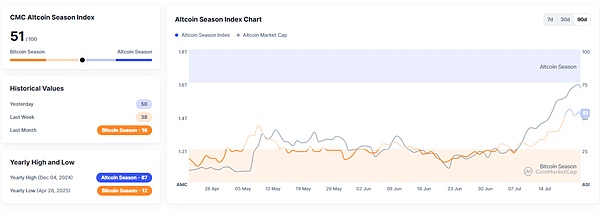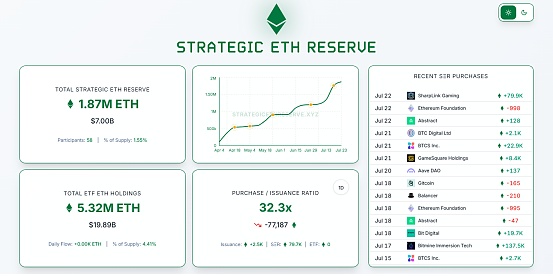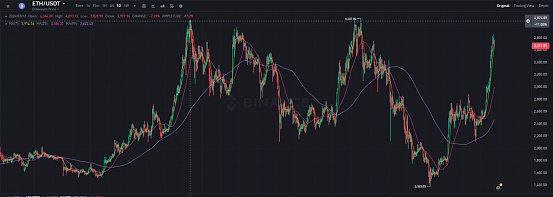The brightest star in the market in July is Ethereum.
As a vane of cottage industry, the spotlight of the market finally shines on ETH once again.
Time came to July, and things took a turn for the better. Suddenly, Ethereum became hot, soaring from $2,400 to $3,860, a rise of more than 60% in one breath. The impact is visible to the naked eye. The monthly return rate of the Defi sector exceeded 40%, and even NFT broke the curse, with the total market value rising above $6 billion, and Cryptopunk was swept up in large amounts. The altcoin season seems to be approaching. The altcoin season index on Coinmarketcap once reached 55, which means that in the past 90 days, 55 of the top 100 currencies by market value have increased more than Bitcoin.

Multiple factors have contributed to the rise of ETH, including the improvement of the macro economy, the opening of policies, the participation of institutions, and its own valuation. But even so, capital drive is still the main reason.

From the perspective of gameplay, Ethereum vaults and Bitcoin vaults have both similarities and differences. On the one hand, listed companies usually accumulate funds quickly through debt or equity financing to hold coins, but on the other hand, compared with traditional Bitcoin treasuries that rely on market value premium to increase stocks for profit, institutions led by SBET and BMNR have adopted the method of staking and earning interest to profit from it. In short, unlike the first type that fully bets on market value speculation and abandons actual control of the business, institutions with more holdings, while retaining their original business, regard Ethereum as a way of investment, and supplement their business segments by pledging it, rather than replacing it. Policy narratives are also conducive to the development of Ethereum. Among the three major crypto bills that have just been passed in the United States, the anti-CBDC regulatory bill lays the ideological foundation for cryptocurrency, the clear bill provides protection for Defi, and the already legislated stablecoin genius bill directly benefits the stablecoin field. It can be said that the three bills have established the dominant position of cryptocurrency in the US digital currency strategy and are beneficial to the entry of traditional institutions. In this context, stablecoins and RWA are the current consensus prospects, and both of them are based on Ethereum. The proportion of Ethereum on the market value of stablecoins is as high as 50%, and RWA is even higher. 7.5 billion of the market value is issued on Ethereum, with a market share of 58.7%.

This uneasiness is also reflected in the data. From Glassnode, the data transferred to the exchange after the price of Ethereum exceeded $2,400 continued to rise. Data from the validator queue tracking website Validatorqueue also showed that as of Tuesday afternoon, US time, about 519,000 ETH (worth $1.92 billion at current prices) were queuing to exit the staking network. This is the largest exit queue size since January 2024, resulting in withdrawal delays extending to more than 9 days. According to past experience, unstaking is usually a precursor to selling. In addition, the decline of the cottage index also reflects that investors are gradually recovering rationality from FOMO. This actually reflects the difference between this rise and the previous ones. In essence, ETH is following the old path of BTC again, and the pricing power is gradually shifting from crypto giants to Wall Street institutions. Before this, ETH did not usher in a huge shock due to the dispersion of holdings and lack of attractiveness, but now, with the relaxation of regulations, institutional buying is accelerating this process. A typical example is that even if there are as many as 519,000 ETHs exiting Ethereum POS, there are also 357,000 ETHs waiting to enter the network. This new demand mostly comes from reserve vault companies. According to Bitwise CIO Matt Hougan's forecast, ETPs and financial companies will purchase $20 billion worth of ETH next year, which is equivalent to 5.33 million ETHs at current prices, equivalent to 7 times the net new supply in the same period.
Objectively speaking, there is no clear negative in the current crypto market from a medium-term perspective. Interest rate cuts are imminent, legislation continues to advance, and new investors continue to increase. From this perspective, even if there is insufficient momentum for growth now, there is no basis for a sharp drop. Of course, local pullbacks and peaks are inevitable, and hedging at key positions will be a more prudent approach.
Unfortunately, if Ethereum's rise is purely driven by ETFs or institutions, perhaps ETH will follow the same script as BTC. Under the premise of limited spillover effects, it is unknown when the cottage season, which urgently needs capital recovery, will come.
 Davin
Davin







